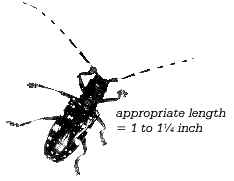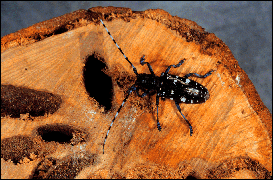

Asian longhorned beetle (ALB) found its way to the United States in wooden pallets and crates from its native China. This beetle attacks a wide range of hardwood trees including ash, elm, birch, poplar, and willow, but has a strong preference for maples. Damage occurs as the larva feeds in the heartwood, making branches more susceptible to wind and storm damage.
At this time, ALB has not been found in Indiana. However, there are several active ALB quarantine sites in the United States and Canada.
- Worcester, MA – Found 2008
- Tate Twp., OH – Found 2011
- Mississauga, Ontario – Found 2013
- Hollywood, South Carolina - Found 2020
Previous ALB sites in Brooklyn, N.Y. (1996), Chicago, Ill. (1998), Jersey City, N.J. (2002) and Vaughn, Ont. (2003) have been declared eradicated.
What to look for:
- The beetle – ALB is a large (1”-1 ½” long), black beetle with random white markings. Its antenna are long with white bands.
- Egg sites – A female will chew 60 to 90 oval depressions in the bark to lay her eggs in. These can often be found on the trunk or undersides of branches.
- Frass – Larva will push course sawdust-like material out of their galleries which may accumulate on branches or around the base of the tree.
- Exit holes – The adults make ¼” or larger, perfectly round holes as they emerge from the tree.
- Broken branches – Check the butt end of broken branches for galleries or tunneling damage.
What you can do to help:
- Don’t move firewood – this is how ALB and many other pests may be introduced.
- Check your trees – take a few minutes to walk your property or neighborhood and check the condition of the trees around you.
- If you see this beetle or notice trees with signs of damage, please report them immediately by calling the DNR at (866) NO-EXOTIC or (866) 663-9684 or emailing DEPP@dnr.IN.gov.
More Information about ALB
- Asian Longhorned Beetle and Its Host Trees - US Forest Service Publication
- Confusion with Asian Longhorned Beetle Look-alikes - Michigan State University Extension
- ALB Look-alikes Poster - Massachusetts Department of Agriculture Resources
- APHIS Information Website
